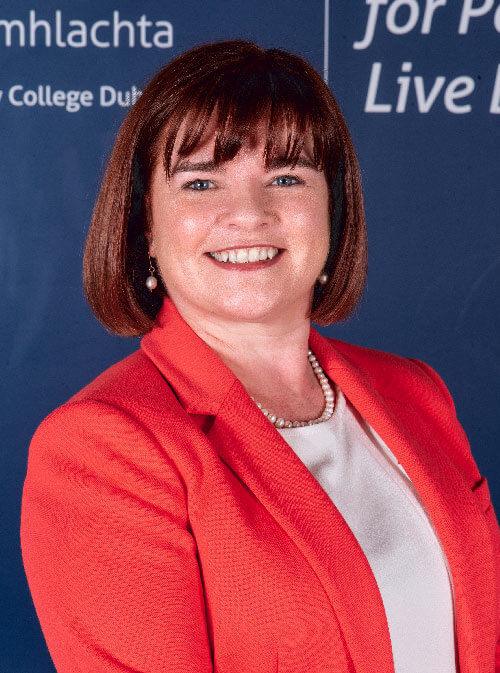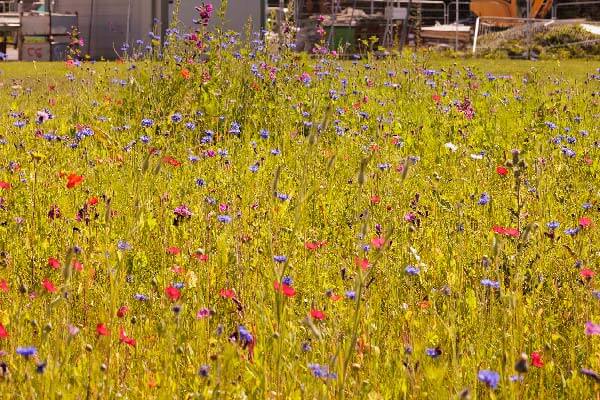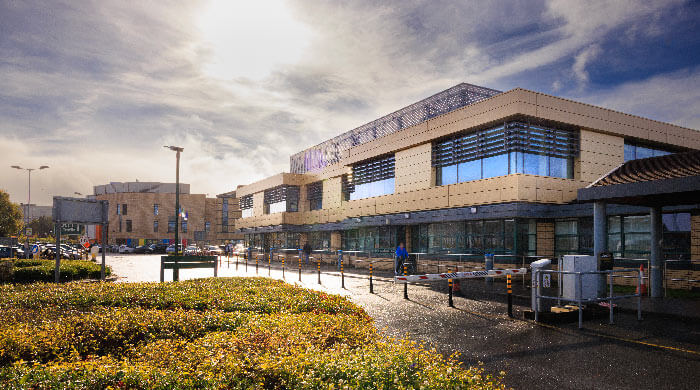
Lucy Nugent
The CEO of one of the country’s leading acute hospitals, which is celebrating its 25th birthday this month doesn’t see robots taking over the running of the hospitals of the future.
Lucy Nugent, CEO, of Tallaght University Hospital (TUH), President of the European Association of Hospital Managers and Council Member of the HMI said she thought that if our philosophy was to truly provide care for patients as well as possible, there would be more remote digital enabled care, which was something she strongly favoured. “However, we still need the human touch and kindness, so I don’t see robots taking over hospitals anytime soon. Healthcare is a human business and it is the kind word from the cleaner or the cup of tea in the middle of the night that is as important as high end drugs,” she said.
She is delighted that TUH has received approval from the HSE for a new inpatient ward block.
There are also major developments in the planning for neurology, the care of older people, population health, women’s health, plastic surgery, trauma, integrated care and plans to build a new Aseptic unit.



It was June 21, 1998, when three independent voluntary hospitals in Dublin, the Adelaide (founded 1839), the Meath (1753) and the National Children’s Hospital (NCH 1821), which had combined to form one hospital, moved to the new €117 million bed hospital at Tallaght. Following some controversy it was named the Adelaide & Meath Hospital, incorporating the National Children’s Hospital, a name it held until March 2018, when it was changed to Tallaght University Hospital, marking its important place in academic, clinical and acute medicine.
On June 21, 1998, a fleet of ambulances with a Garda escort, moved the first 115 patients from the Adelaide, the Meath and the National Children’s Hospital to the new modern hospital on a 33-acre site in Tallaght.
The building of the Hospital was, at the time one of the largest capital investments in healthcare ever undertaken by the State. Designed by Robinson Keefe Devane, the new hospital had 452 beds, 12 theatres and 14 Critical Care beds. Construction had been approved in 1993. Building commenced in October of that year and was completed in 1998.
The Hospital itself was established under a Charter, agreed in Dáil Éireann, on August 1, 1996.
On the June day when patients and staff were being transferred to the new hospital, a team of medical and nursing staff was on stand-by at the Meath Hospital, the Adelaide Hospital and the National Children’s Hospital in Harcourt Street and in Tallaght. Prior to opening day, a removal company was hired to pack and move furniture, equipment and files. Over 170,000 patient records and almost 50,000 patients’ X-Rays were transferred from the three hospitals to the new building.
It was a unique challenge, bringing together over 600 years of medical and nursing care and education from the very different traditions of the Adelaide Hospital, the Meath Hospital and the National Children’s Hospital.
Today, just putting up the original building in Tallaght would cost €519 million. In 1998, the Hospital cost €70m per year to run. It will cost €355m this year.
In recent years, over €50M has been invested in physical expansions to the Hospital. The developments have included an ED expansion, opening of clinics off site in the Simms building, an ICU extension, the Vartry Renal Unit, Tymon North, the Reeves Day Surgery Centre, CRY, significant redevelopments of Oncology and Haematology wards and the Rynd building for phlebotomy and infusions.
The three hospitals which merged to form the new Meath Adelaide Hospital, incorporating the National Children’s Hospital, employed a total of 1,600 staff.
As the Hospital celebrates its 25th birthday, over 300 of the staff who were there on the first day, are still working in the Hospital, now named Tallaght University Hospital. TUH now employs over 3,500 staff, with 63 nationalities represented, and is one of the largest employers in Tallaght.
The CEO says that when the Hospital was first designed, an additional 120 beds were to have been provided, but these fell victim to lack of funding. “Now because of the increased number of older people and our growing demographic, these additional beds are key to addressing the challenges facing the hospital,” she said.
She said TUH was looking forward to being part of the new Trauma Network and to having a trauma unit in 2025.
The Hospital has received approval for the appointment of two Consultant Plastic Surgeons and funding for the development of plastic surgery which will support the new Trauma Unit.
They were also delighted to be designated as the supra- regional women’s health unit for the Eastern seaboard and are in the middle of developing a dedicated Women’s Ambulatory Hub across the road from the hospital in the Tallaght Health Quarter, where many new services are now located.
An expansion is also planned to the Community Radiology Facility in the Tallaght Health Quarter, which is owned by the HSE and under the clinical governance of TUH. The expansion will include CT and MRI facilities. The Hospital has also commissioned two new endoscopy rooms to cater for the growing demand, which will ensure patients have early and timely access to diagnostics.
This is all underpinned by digital enabled health technology. The Hospital has a digital first philosophy and is very conscious of the environmental impact of paper and reducing unnecessary manual processes.
Conscious of the environmental impact of healthcare on greenhouse emissions the Hospital is striving to reduce its carbon footprint. The replacement of all the hospital’s light bulbs with LED, changes in pumps and air handling units combined have resulted in a 20 per cent drop in electrical consumption onsite.
Lucy said TUH was already a leading hospital for a number of specialties when it opened. “We are delighted to have leaders in the care and treatment of older people and those with neurology diseases in our Institute of Memory & Cognition. Prof. Seán Kennelly, Consultant Geriatrician and Prof. Sean O’Dowd, Consultant Neurologist are pioneers in the area. With the advent of new drugs which will not cure diseases like Parkinson’s or Alzheimer’s, but will help mitigate their effects, it is a very exciting area of medicine. We are also part of the European Rare Diseases’ Network, a network of healthcare providers, each from different disciplines across the European Union who work together to provide specialised treatment and resources for patients with rare and complex conditions or diseases.”
The Hospital, with its dedicated purpose-built Vartry Unit, is the second largest site for dialysis in the country. Last year 2,153 patients received maintenance in-centre haemodialysis in the Hospital. There was also a welcome increase in Kidney Transplantation activity in 2022, with 163 people receiving a kidney transplant.
The Institute of Memory & Cognition in TUH is one of Europe’s leading clinical memory services. This interdisciplinary specialist memory unit consists of The National Intellectual Disability Memory Service (NIDMS), The Regional Specialty Memory Service (RSMS) and the Cognitive Clinical Trial Unit (CCTU).
TUH has been to the forefront of integrated care long before the Sláintecare report. Said Lucy Nugent, “We value the relationship with our GP and community partners in primary care. They have been very effective in breaking down barriers, with our focus always on the patient journey. The key specialties on which the Integrated Care Programme for the prevention and management of chronic disease, are focussing at present are endocrinology, specifically diabetes, respiratory and cardiology and the care of older persons.
“The Hospital’s work on integrated care is supported by our academic primary care partnership with TCD and their Institute of Population Health to ensure we are researching the needs of our population. The Institute of Population Health is situated across the road from the TUH campus and Prof Susan Smith is the first Chair of General Practice who actually has contractual sessions in the hospital as well as her outreach work.”
Lucy Nugent says she believes it wonderful that the Hospital came into being as a result of the merger of three founding hospitals. “There is a very strong, proud heritage and we value that heritage and those innovators and advocates for a better health system for all. It is where we came from, but we also believe we must be forward looking and progress innovative health to ensure we are fit for the future. We are eagerly looking forward to the introduction of the Regional Health Areas and to working in partnership with the HSE and the Department of Health, based on the partnership principles recently launched by the Minister for Health.
“Staff wellness and welfare are our priorities. We have a Health & Well-Being officer, Victoria Jones, and we are very proud to be accredited with The Ibec Keep Well Mark in recognition of the Hospital’s commitment to the health & wellbeing of staff. We are the only publicly funded hospital in the country to achieve this recognition. The evidence based accreditation process focuses on eight key themes of workplace wellbeing including leadership, health and safety, absence management, healthy eating, physical activity, mental health, intoxicants, a smoke-free environment and how they impact across the organisation.
“We spend one-third of our lives at work, and in TUH, we want to attract people to come and work with us and then develop them, their skills and expertise and retain them. We have a Leadership Academy as well as coaching and mentoring programmes. Our emphasis is on the development of the employees’ journey. Our Centre for Learning and Development have over 150 different courses which staff can undertake on site and that is often reflected in people caring for people and helping them to live better lives.
“An example of leadership in our organisation is that when people see a problem, they develop a solution. We are a learning organisation and we are very solution focused. Our phlebotomy course is an example of management, staff, our academic partners in TCD and many other stakeholders working together solving a recruitment challenge but also providing opportunities for career growth for our staff. “
The Hospital has a digital first philosophy and has introduced an electronic patient record, said Lucy. “This has proven very important from the patients’ point of view and we are also developing a patient portal as we recognise we are partners in their care.
“One of the main core values of the Hospital is Respect, not just for our patients and one another but also for our environment. As we all become increasingly aware of the environmental challenges we are facing there is the most positive partnership of staff and management working together on a ‘Green Committee. Recognition that we all need to continue to work together on addressing the challenges we collectively face. Keep Cups have been introduced in the canteen saving the use of 500,000 disposable cups each year, sustainability green initiatives are now being included in contract scoring, when you have such a large organisation with so many staff all of these changes add up to making a significant difference. There are also the small changes that improve the surroundings for patients and staff. with the introduction of wild flower meadows and bee hives where we produce our own honey.”
Most importantly Lucy Nugent said that “Being a people business I would like to not only acknowledge the fantastic and dedicated staff but also the wider Tallaght community who fought for this Hospital and continue to engage with us on how we can continue to contribute to the health of the population we serve.”

